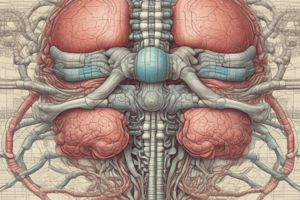Podcast
Questions and Answers
How are spinal nerves named and numbered?
How are spinal nerves named and numbered?
- In sequential order from top to bottom along the spinal cord
- By the region and level of the vertebral column where they arise (correct)
- According to the specific muscles they innervate
- Based on their function as sensory or motor nerves
Why are all spinal nerves classified as mixed nerves?
Why are all spinal nerves classified as mixed nerves?
- Containing both sensory and motor neurons (correct)
- Being solely responsible for motor control
- Because they transport impulses within the central nervous system
- Due to containing only sensory neurons
How do the spinal nerves connect to the spinal cord?
How do the spinal nerves connect to the spinal cord?
- By the interneurons (correct)
- Through sensory neurons
- Via the motor neurons
- Directly through the brainstem
What regions of the body are supplied by plexuses, according to the text?
What regions of the body are supplied by plexuses, according to the text?
What is the main function of a stretch reflex?
What is the main function of a stretch reflex?
In relation to reflex arcs, what does 'ipsilateral' mean?
In relation to reflex arcs, what does 'ipsilateral' mean?
Where is the epidural space located in relation to the spinal meninges?
Where is the epidural space located in relation to the spinal meninges?
What is the location of the lumbar enlargement?
What is the location of the lumbar enlargement?
What is the function of the filum terminale?
What is the function of the filum terminale?
At which level does the conus medullaris typically end in adults?
At which level does the conus medullaris typically end in adults?
What characterizes the cauda equina?
What characterizes the cauda equina?
What is a distinguishing feature of a spinal segment?
What is a distinguishing feature of a spinal segment?
Flashcards are hidden until you start studying
Study Notes
Spinal Cord Structure
- The spinal cord is partially divided into right and left sides by the anterior median fissure and posterior median sulcus.
- The spinal cord has cervical and lumbar enlargements, which are regions of the spinal cord that give rise to nerves that innervate the upper and lower limbs.
Spinal Nerves
- Spinal nerves are named and numbered by the region and level of the vertebral column where they arise.
- All spinal nerves are classified as mixed nerves because they contain both sensory and motor neurons.
- They transport motor impulses away from the central nervous system and sensory impulses towards it.
Connection to Spinal Cord
- Spinal nerves connect to the spinal cord at the intervertebral foramen.
- The posterior and anterior roots unite to form a spinal nerve at the intervertebral foramen.
Nerve Distribution
- Plexuses (branchial, lumbar, sacral, and cervical) supply nerves to specific regions of the body.
- Intercostal nerves supply nerves to the thorax region.
Reflexes
- Stretch reflex: a mechanism that enables skeletal muscle length control on an automated basis, contracting a muscle as it is stretched to avoid overstretching.
- Tendon reflex: a feedback system that regulates muscular tension by inducing muscle relaxation prior to the occurrence of high enough muscle force to potentially tear the tendons.
- Crossed extensor reflex: a mechanism that rapidly removes the injured limb from unpleasant stimuli while stabilizing the body to preserve balance and posture.
Reflex Arcs
- Monosynaptic: a reflex arc with a single synapse between the sensory neuron and motor neuron.
- Ipsilateral: occurring on the same side of the body.
Meninges and Spaces
- Spinal meninges: protective membranes that cover the spinal cord.
- Epidural space: located between the bony wall of the vertebral canal and the outer surface of the dura mater.
- Subarachnoid space: located deep within the arachnoid membrane, between it and the pia mater.
Spinal Cord Features
- Conus medullaris: the lower end of the spinal cord, ending at the level of the intervertebral disc between the first and second lumbar vertebrae (L1-L2) in adults.
- Filum terminale: a fibrous band that extends inferiorly and fuses with the arachnoid mater and dura mater, anchoring the spinal cord.
- Cauda equina: a collection of nerves and nerve roots that emerge from the spinal cord's distal end.
- Spinal segment: the dorsal roots and ventral roots exiting the cord, giving rise to nerves.
Studying That Suits You
Use AI to generate personalized quizzes and flashcards to suit your learning preferences.




